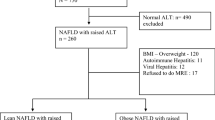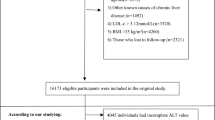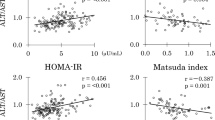Abstract
Objective: To determine the prevalence of fatty liver and alanine aminotransferase (ALT) elevation in obese Japanese women and to clarify the factors contributing to fatty change and ALT elevation in the cohort.
Design: Cross-sectional and population-based study.
Subjects: From 4366 women who received their annual health check-up, 4211 women were selected for analysis. All 4211 women were negative for hepatitis virus markers.
Measurements: Peripheral blood cell counts, liver biochemical tests, fasting glucose, cholesterol and triglyceride levels, uric acids, glycosylate hemoglobin A1c, and ultrasound examination.
Results: Ultrasonographic evidence of fatty liver and ALT elevation was seen in 391 (9.3%) and 238 (5.7%), respectively, of the 4211 women. Frequencies of both fatty liver and ALT elevation increased with increase in the degree of obesity. The frequency of ALT elevation was higher in women with fatty liver than in women without fatty liver among the nonobese or mildly obese group. However, the frequency of ALT elevation was not significantly different between women with fatty liver and women without fatty liver among the severely obese group. Multivariate analysis showed that obesity, hemoglobin (≥14 g/dl), triglyceride (≥150 mg/dl), diabetes mellitus, and fatty liver were significant predictors of ALT elevation. However, only two variables, hemoglobin (≥14 g/dl) and presence of diabetes, were significant in the severely obese group.
Conclusions: ALT elevation not associated with fatty liver was frequently seen in obese women, suggesting that obesity is directly associated with the elevated ALT level in Japanese obese women. In addition, hemoglobin (≥14 g/dl) was a strong predictor of ALT elevation in the severely obese group.
This is a preview of subscription content, access via your institution
Access options
Subscribe to this journal
Receive 12 print issues and online access
$259.00 per year
only $21.58 per issue
Buy this article
- Purchase on Springer Link
- Instant access to full article PDF
Prices may be subject to local taxes which are calculated during checkout
Similar content being viewed by others
References
Bacon B, O'Neill R & Britton R (1993): Hepatic mitochondrial energy production in rats with chronic iron overload. Gastroenterology 105, 1134–1140.
Bacon BR, Farahvash MJ, Janney CG & Neushwander-Tetri BA (1994): Nonalcoholic steatohepatitis: an expanded clinical entity. Gastroenterology 107, 1103–1109.
Bonkovsky HL, Banner BF & Rothman AL (1997): Iron and chronic viral hepatitis. Hepatology 25, 759–768.
Coughlin S, Calverley P & Wilding J (2001): Sleep disordered breathing — a new component of syndrome X. Obes. Rev. 2, 267–274.
Day CP & James CFW (1998): Steatohepatitis: a tale of two “hit”? Gastroenterology 114, 842–845.
Day CP (2002): Non-alcoholic steatohepatitis (NASH): where are we now and where are we going? Gut 50, 585–588.
De Fronzo RA & Ferrannini E (1991): Insulin resistance. A multifaceted syndrome responsible for NIDDM, obesity, hypertension, dyslipidemia, and atherosclerotic cardiovascular disease. Diabetes Care 14, 173–194.
Falck-Ytter Y, Younossi ZM, Marchesini G & McCullough AJ (2001): Clinical features and natural history of nonalcoholic steatosis syndromes. Semin. Liver Dis. 21, 17–26.
Fargion S, Mattioli M, Fracanzani AL, Sampietro M, Tavazzi D, Fociani P, Taioli E, Valenti L & Fiorelli G (2001): Hyperferritinemia, iron overload, and multiple metabolic alterations identify patients at risk for nonalcoholic steatohepatitis. Am. J. Gastroenterol. 96, 2448–2455.
Hamaguchi K & Sakata T (2001): Epidemiology of obesity. Kan-Tan-Sui 42, 9–18, (in Japanese).
Harrison SA, Kadakia S, Lang KA & Schenker S (2002): Nonalcoholic steatohepatitis: what we know in the new millennium. Am. J. Gastroenterol. 97, 2714–2724.
James OFW & Day CP (1998): Non-alcoholic steatohepatitis (NASH): a disease of emerging identity and importance. J. Hepatol. 29, 495–501.
Kissebah AH & Krakower GR (1994): Regional adiposity and morbidity. Physiol. Rev. 74, 761–811.
Kopelman PG (2000): Obesity as a medical problem. Nature 404, 635–643.
Kuczmarski RJ, Carroll MD, Flegal KM & Triano RP (1997): Varying body mass index cut–off points to describe overweight prevalence among US adults. NHANES III (1988–1994). Obes. Res. 5, 542–558.
Luce JM (1980): Respiratory complication of obesity. Chest 78, 626–631.
Ludwig J, Viggiano TR, McGill DB & Ott BJ (1980): Nonalcoholic steatohepatitis: Mayo Clinic experience with a hitherto unnamed disease. Mayo Clinic. Proc. 55, 434–438.
Mendler MH, Turlin B, Moirand R, Jouanolle AM, Sapey T, Guyader D, Le Gall JY, Brissot P, David V & Deugnier Y (1998): Insulin resistance-associated hepatic iron overload. Gastroenterology 117, 1155–1163.
Messinezy M & Pearson TC (1990): A retrospective study of apparent and relative polycythemia: associated factors and early outcome. Clin. Lab. Haemat. 12, 121–129.
Moller DE & Flier JS (1991): Insulin resistance. Mechanism, syndromes, and implications. N Engl. J. Med. 325, 938–948.
Nishioka K, Watanabe J, Furuta S, Tanaka E, Suzuki H, Iino S, Tsuji T, Yano M, Kuo G & Choo GL (1991): Antibody to the hepatitis C virus in acute hepatitis and chronic liver disease in Japan. Liver 11, 65–70.
Nomura H, Kashiwagi S, Hayashi J, Kajiyama W, Tani S & Goto M (1988): Prevalence of fatty liver in a general population of Okinawa, Japan. Jpn. J. Med. 27, 142–149.
Ray C, Sue D, Bray G, Hansen J & Wasserman K (1983): Effect of obesity on respiratory function. Am. Res. Respir. Dis. 128, 501–550.
Sakugawa H, Nakasone H, Nakayoshi T, Kawakami Y, Yamashiro T, Maeshiro T, Kinjo F, Saito A & Yakabi S (2003): Alanine aminotransferase (ALT) levels in a normal population and interferon therapy in chronic hepatitis C patients with normal ALT. Hepato-Gastroenterol 50, 165–169.
Savertmuttu SH, Joseph AEA & Maxwell JD (1986): Ultrasound scanning in the detection of hepatic fibrosis and steatosis. Br. Med. J. 292, 13–15.
Sheth S (1997): Nonalcoholic steatohepatitis. Ann. Intern. Med. 126, 137–145.
Takahashi Y, Noda M, Tsugane S, Kuzuya T, Ito C & Kadowaki T (2000): Prevalence of diabetes estimated by plasma glucose criteria combined with standardized measurement of HbA1c among health checkup participants on Miyako island, Japan. Diabetes Care 23, 1092–1096.
The Committee of Japan Diabetes Society for the Diagnostic Criteria of Diabetes Mellitus (1999): report of the committee of Japan Diabetes Society on the classification and Diagnostic Criteria of Diabetes Mellitus. J. Jpn. Diabetes Soc. 42, 385–404.
Yamada G, Tanaka E, Miura T, Kiyosawa K, Yano M, Matsushima T, Tsubouchi H, Ishikawa K, Kohara M & Hino K (1995): Epidemiology of genotype of hepatitis C virus in Japanese patients with type C chronic liver diseases: a multi-institution analysis. J. Gastroenterol. Hepatol. 10, 538–545.
Yano E, Tagawa K, Yamaoka K & Mori M (2001): Test validity of periodic liver function tests in a population of Japanese male bank employees. J. Clin. Epidemiol. 54, 945–951.
Yoshiike N, Matsumura Y, Zaman MM & Yamaguchi M (1998): Descriptive epidemiology of body mass index in Japanese adults in a representative sample from the National Nutrition Survey 1990–1994. Int. J. Obes. Relat. Metab. Disord. 22, 684–687.
Acknowledgements
We are grateful to Dr Kozen Kinjo and other staff members in the Okinawa General Health Service Association for their kind cooperation.
Author information
Authors and Affiliations
Corresponding author
Rights and permissions
About this article
Cite this article
Sakugawa, H., Nakayoshi, T., Kobashigawa, K. et al. Alanine aminotransferase elevation not associated with fatty liver is frequently seen in obese Japanese women. Eur J Clin Nutr 58, 1248–1252 (2004). https://doi.org/10.1038/sj.ejcn.1601956
Received:
Revised:
Accepted:
Published:
Issue Date:
DOI: https://doi.org/10.1038/sj.ejcn.1601956



